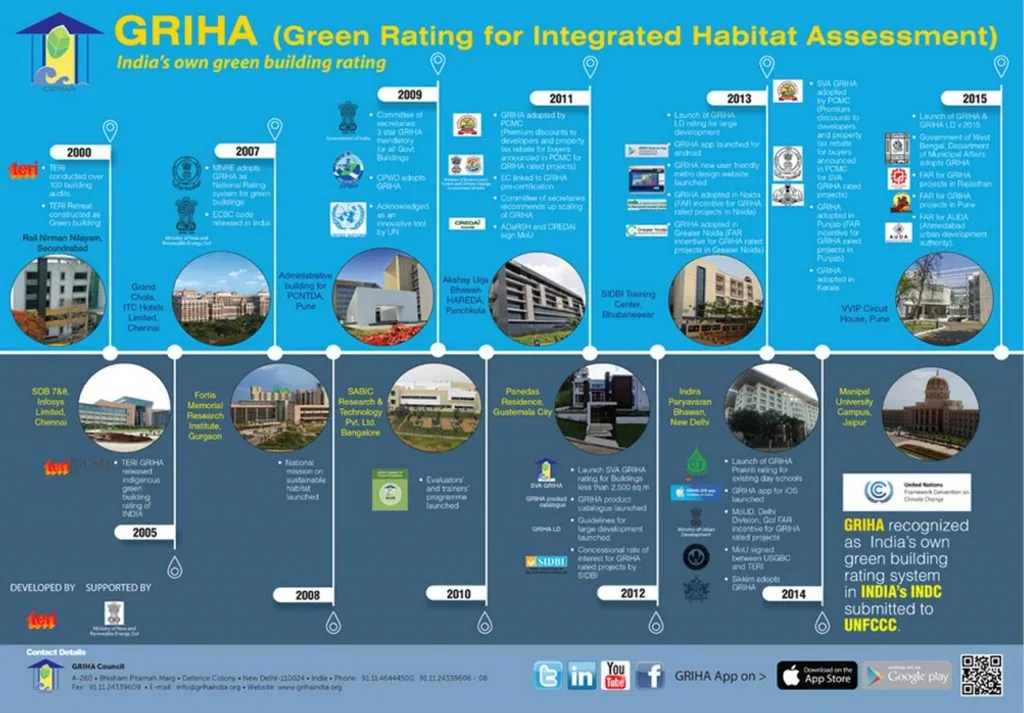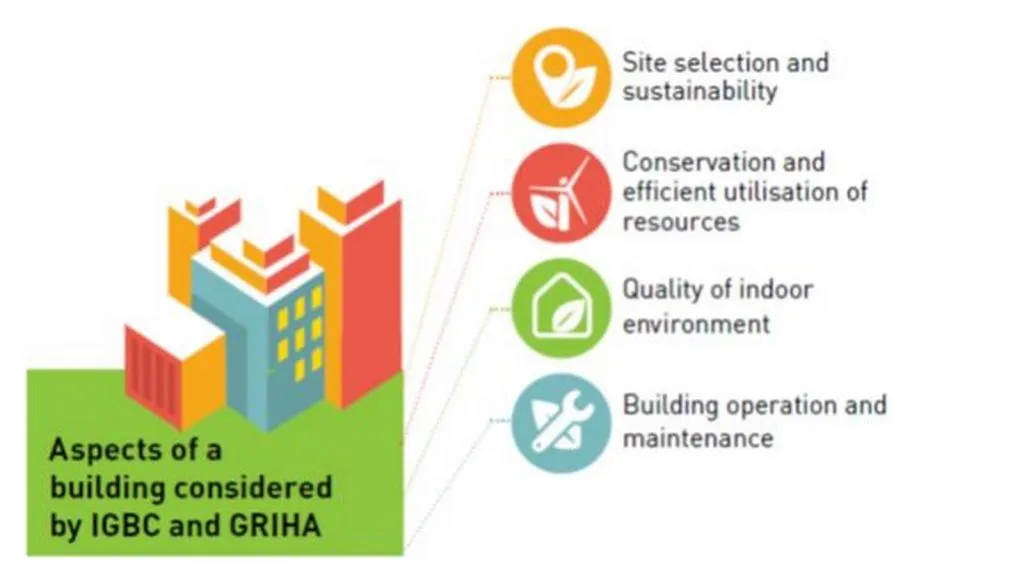Sustainability is no longer a buzzword—it’s a necessity. With environmental challenges like climate change and water scarcity reshaping the way we think about construction and urban planning, green certifications like GRIHA (Green Rating for Integrated Habitat Assessment) are growing in importance. For architects, urban planners, and environmentalists, GRIHA offers a practical pathway to design sustainable habitats while aligning with global green building standards.
But what exactly does GRIHA certification entail? How can it transform your projects, and where do Rainwater Harvesting Solutions fit into the equation? This article will guide you through everything you need to know.
GRIHA Certification
GRIHA Certification is India’s national green building rating system. Developed by TERI (The Energy and Resources Institute) and validated by the Ministry of New and Renewable Energy (MNRE), it serves as a benchmark to evaluate the sustainability of building projects.
Unlike other international certification systems, GRIHA is designed specifically to address issues relevant to India, such as water scarcity, energy conservation, and waste management. Whether you’re designing a residential complex, commercial facility, or urban layout, GRIHA provides a comprehensive framework to ensure that your project is environmentally responsible.
The Core of GRIHA
GRIHA Certification evaluates projects on a wide array of parameters, such as energy efficiency, water management, waste reduction, and indoor environment quality. By setting measurable benchmarks, it not only promotes sustainability but also enhances the well-being of the individuals living or working in these spaces.
Points are awarded based on the achievement of specific metrics, and the building’s performance is evaluated across its lifecycle—from the planning stage to operational maintenance.

Why Choose GRIHA?
For developers, architects, and planners, GRIHA Certification offers several benefits.
- Environmental Responsibility: Aligns your project with India’s sustainable development goals.
- Operational Savings: Energy-efficient designs reduce long-term operational costs.
- Recognition: Establishes your project as a frontrunner in sustainable architecture.
- Urban Resilience: Contributes to smarter, more resilient cityscapes.
Whether you’re incentivized by government policies or genuinely committed to sustainability, GRIHA certification provides a structured way to make your project greener.
Government-backed Incentives for Green Builders
To encourage eco-friendly construction, the Indian government provides various incentives linked to GRIHA standards:
- Maharashtra (Pune Municipal Corporation): Developers receive premium charge discounts based on GRIHA star ratings.
- Rajasthan (Jaipur Development Authority): Additional 5% FAR is granted for buildings larger than 5,000 m² achieving a 4- or 5-star rating.
- Punjab (Department of Housing and Urban Development): Buildings certified by GRIHA or the Bureau of Energy Efficiency can avail an extra 5% FAR free of charge under the Punjab Regional and Town Planning and Development Act, 1995.
Getting GRIHA Certification in Five Steps
While the process might seem intimidating at first, obtaining GRIHA certification is straightforward if you follow these steps:
1. Understanding the Criteria
Review the GRIHA Manual to familiarize yourself with the evaluation criteria. These include site selection, energy efficiency, water management, materials recycling, and indoor environmental quality.
Pro Tip 💡 Working with experts like NIPSTec can help you incorporate efficient Rainwater Harvesting Systems that integrate naturally into GRIHA’s water management standards.
2. Application Submission
Once you’ve planned the sustainability aspects of your project, you’ll need to formally register it for GRIHA certification. Provide key project details such as location, type of construction, and environmental goals.
3. Collaborate with GRIHA Evaluators
During the design and planning stages, you’ll work closely with GRIHA evaluators to fine-tune your project. They’ll guide you on how best to meet specific benchmarks and maximize your score.
4. Implement Sustainable Solutions
Now comes the execution phase. This is where you’ll actively implement solutions in waste management, renewable energy, and water conservation. Rainwater Harvesting, for example, is an essential solution that contributes directly to your GRIHA points under water management parameters. NIPSTec offers end-to-end consulting and installation services across major states like Maharashtra, Haryana, Delhi, Uttar Pradesh, Himachal Pradesh, Punjab and Rajasthan.
5. Earn Your GRIHA Certification
After implementation, your project undergoes a final evaluation. This is when your accumulated points are counted and a certification level is awarded depending on your score.

What’s the Minimum Score for GRIHA Certification?
To achieve GRIHA certification, projects must achieve at least 25 points on the evaluation scale. However, to truly make an impact and enhance your project’s green branding, it’s beneficial to aim for higher scores and secure a 4- or 5-star rating.
| Points | Star Rating |
| 25–40 | 1 Star Certification |
| 41–55 | 2 Stars Certification |
| 56–70 | 3 Stars Certification |
| 71–85 | 4 Stars Certification |
| 86–100 | 5 Stars Certification |
The higher your score, the greater the recognition your project will receive for its sustainability efforts, and the more significant its long-term benefits.
Rainwater Harvesting’s Contribution to Earning GRIHA Points
Water management is one of the core parameters in the GRIHA framework, and few solutions are as impactful or cost-effective as Rainwater Harvesting. Efficient Rainwater Harvesting systems can drastically reduce your building’s reliance on municipal water supplies, ensuring compliance with sustainability benchmarks.
NIPSTec specializes in providing tailored Rainwater Harvesting Solutions for residential, commercial, and urban projects. Our team offers a full range of services, including consultancy, site surveys, system installation, and maintenance. With experience in regions like Maharashtra, Uttar Pradesh, Punjab, Haryana, Himachal Pradesh and Delhi NCR, we deliver solutions that align seamlessly with GRIHA’s guidelines.
Key Services We Offer:
- Rooftop and Modular Rainwater Harvesting Systems
- Installation of FRP Filters and Vee-Wire Filter Screens
- Maintenance Services, including digital water flow meters and piezometer installations
Why GRIHA Matters to Urban Planners and Architects
While GRIHA is a sustainability tool, it’s also a badge of credibility. It signals to stakeholders that your project prioritizes efficiency, environmental responsibility, and resilience.
For architects, GRIHA pushes boundaries to design spaces that are not just functional but also transformational. For urban planners, it’s an essential tool in creating cities that are more adaptive to climate challenges. And for environmentalists, it’s a confirmation that a green future is achievable with a collaborative effort.
Internationally, GRIHA (Green Rating for Integrated Habitat Assessment) has earned recognition as a tool for driving sustainability in the built environment. It has been acknowledged for various contributions:
- Innovative Solutions for Sustainability: Developed under the guidance of the United Nations, GRIHA supports the global push for sustainable development.
- Focus on Renewable Energy Implementation: Recognized by ‘The Climate Reality Project,’ founded by Al Gore, as a tool to integrate renewable energy practices within the building sector.
- Global Standards in Carbon Metrics: GRIHA has contributed to UNEP-SBCI’s “Common Carbon Metric” for gathering international building energy data.
National Implementation in India
Within India, GRIHA has proven instrumental in promoting environmentally responsible construction practices:
- Policy Integration: The Ministry of Environment, Forest, and Climate Change (MoEF) has approved GRIHA pre-certification for expedited environmental clearances.
- Regional Incentives:
- Pimpri Chinchwad Municipal Corporation (Maharashtra) offers financial advantages, including up to a 50% rebate in premiums for GRIHA-compliant projects.
- NOIDA Authority has introduced an FAR (Floor Area Ratio) incentive program for 4-star and 5-star rated GRIHA projects.
- Government Adoption:
- Various government entities, including CPWD (Central Public Works Department), DDA (Delhi Development Authority), NBCC (National Buildings Construction Corporation), and BHEL (Bharat Heavy Electricals Limited), have embraced GRIHA standards by revising guidelines to include mandatory 3-star compliance.
- Public Works Departments in Kerala and Assam have integrated GRIHA into their operations.
- The Government of Delhi and Chandigarh Administration have also officially adopted GRIHA certification protocols.
Build Green. Build Smart.
Sustainability in construction isn’t optional—it’s a responsibility. Achieving GRIHA certification is an opportunity to enhance your projects while answering urgent environmental needs. And when it comes to seamlessly integrating water conservation into your planning, Rainwater Harvesting is a game-changer.
Looking to elevate your project with tailored Rainwater Harvesting solutions? Contact NIPSTec today for expert consultation and installation services that align with GRIHA certification goals. Together, we can build a greener future.
References:


